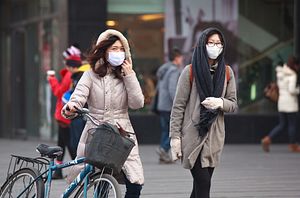It is tempting to write-off China’s environmental situation as simply a moment in time. The imperative of lifting hundreds of millions of people out of poverty while managing the economic demands of a burgeoning middle class is bound to take a toll on any country’s environment. Many commentators see China as now reaching the inflection point attained by the United States in the 1960s and 70s, where rising incomes, citizen awareness, and government priorities combined to produce a shift in how Americans understood the relationship between development and the environment. What American alive during that time could forget the contamination of the Love Canal, the burning of the Cuyahoga River, and Rachel Carson’s devastating expose of the impact of pesticides on the environment in triggering a new approach to environmental protection in the United States?
Chinese officials also like to compare China today with other countries during their periods of industrialization. As Beijing Environmental Protection Bureau official Wang Bin has claimed, “You can see in those big cities like in London in Britain, Los Angeles in America and Tokyo in Japan, they all had huge air problems in the past—for example, London was nicknamed Smog City—which was caused by fast industrialization. But their situation has improved a lot and their air is really better now. Beijing’s pollution is not that severe. We have already moved fast to cope with this issue.”
Yet after two decades of thinking and writing about China’s environment, I have come to think that such comparisons, while not entirely misplaced, are nonetheless misleading. The scale and scope of the environmental challenge that China faces today and that faced by the United States in the 1960s and 1970s are vastly different. The population pressures on the environment and resources, for example, are not of the same magnitude. While the size of both countries is roughly equal, from 1962 to 1982, the U.S. population grew from roughly 192 million to 232 million; by 1982, the Chinese population had already topped one billion and today stands at over 1.3 billion.
Unlike the situation in the United States, moreover, China’s environmental degradation and pollution are not simply a function of decades of rapid economic growth; rather they have been hundreds and sometimes—as in the case of deforestation and land degradation—over two thousand years in the making. As early as the Han dynasty (220 B.C.E.-220 C.E.), Chinese writers decried the deterioration and exploitation of their environment as a result of economic development. By the time Deng Xiaoping began the wave of economic reform in the late 1970s and early 1980s that would produce the Chinese economic miracle of today, China already faced an environmental disaster. In his 1999 book Environmental Management in China, Qu Geping, who served as the first head of the country’s environmental protection agency, described the environment in the 1960s thus: “A lot of places were polluted by either smog, sewage waters or rubbish. Mineral resources were also exploited, resulting in startling losses and destruction to both topography and landscape. Biological resources, forests in particular were seriously damaged, causing several losses to the ecosystem. There was extensive destruction of the natural environment of our country.”
Even more importantly, the institutions that underpin the two countries’ environmental protection efforts are radically different. Like the United States, China began developing many of its environmental institutions and laws in the wake of the 1972 United Nations Conference on the Human Environment. Yet the transparency, official accountability, and rule of law—however imperfect—that became the mainstay of environmental protection in the United States eluded and continue to elude China. Despite some progress, Beijing still works to limit transparency, refusing, for example, to release the results of a 2006 soil pollution survey on the grounds that it is a “state secret”; it controls access to the legal system in order to limit the number of environmental lawsuits; and it offers few institutionalized means by which the public can participate in the process of environmental debate and decision-making.
Yet in one crucial respect, China is following in the United States’ footsteps. One outgrowth of citizen awareness in the United States during the 1960s and 1970s was the establishment of non-governmental organizations, such as the Environmental Defense Fund and Natural Resources Defense Council, that drove the U.S. government to adopt more stringent environmental protection laws and regulations. Today there are thousands of Chinese environmental NGOs—many of which work with their U.S. counterparts—that push local officials to reveal accurate pollution statistics, work with Chinese journalists to investigate corruption, and launch public campaigns against corporations that break environmental laws and regulations. The Chinese people are energized as well. The environment has become the largest source of the more than 180,000 demonstrations that rock China every year.
China’s new leaders are working hard to turn the environmental situation around, but overwhelmingly within the parameters of their traditional approaches: top-down targets for everything from the number of steel plants to the number of cars on the road; a belief that technology can solve all their problems (even if the incentives for deploying the technology remain skewed against its implementation); and a demand that local officials bear the burden of improving the environment (still without providing them much in the way of additional resources to do so). Yet if the leaders are still largely stuck thinking inside the box, the Chinese people are not. While Beijing may demand change from on high, the Chinese people are forcing change from below. This bottom-up pressure represents the American political tradition at its best.
Elizabeth C. Economy is C.V. Starr Senior Fellow and Director for Asia Studies at the Council on Foreign Relations. She is an expert on Chinese domestic and foreign policy and U.S.-China relations and author of the award-winning book, The River Runs Black: The Environmental Challenge to China’s Future. She blogs at Asia Unbound, where this piece originally appeared.
































